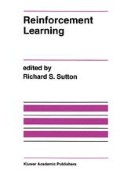Abstract
This article presents a general class of associative reinforcement learning algorithms for connectionist networks containing stochastic units. These algorithms, called REINFORCE algorithms, are shown to make weight adjustments in a direction that lies along the gradient of expected reinforcement in both immediate-reinforcement tasks and certain limited forms of delayed-reinforcement tasks, and they do this without explicitly computing gradient estimates or even storing information from which such estimates could be computed. Specific examples of such algorithms are presented, some of which bear a close relationship to certain existing algorithms while others are novel but potentially interesting in their own right. Also given are results that show how such algorithms can be naturally integrated with backpropagation. We close with a brief discussion of a number of additional issues surrounding the use of such algorithms, including what is known about their limiting behaviors as well as further considerations that might be used to help develop similar but potentially more powerful reinforcement learning algorithms.
Access this chapter
Tax calculation will be finalised at checkout
Purchases are for personal use only
Preview
Unable to display preview. Download preview PDF.
References
Barto, A.G. (1985). Learning by statistical cooperation of self-interested neuron-like computing elements.Human Neurobiology, 4, 229–256.
Barto, A.G. & Anandan, P. (1985). Pattern recognizing stochastic learning automata.IEEE Transactions on Systems Man and Cybernetics, 15, 360–374.
Barto, A.G. & Anderson, C.W. (1985). Structural learning in connectionist systems.Proceedings of the Seventh Annual Conference of the Cognitive Science Society(pp. 43–53). Irvine, CA.
Barto, A.G., Sutton, R.S., & Anderson, C.W. (1983). Neuronlike elements that can solve difficult learning control problems.IEEE Transactions on Systems,Man,and Cybernetics, 13, 835–846.
Barto, A.G., Sutton, R.S., & Brouwer, P.S. (1981). Associative search network: A reinforcement learning associative memory.Biological Cybernetics, 40, 201–211.
Barto, A.G., & Jordan, M.I. (1987). Gradient following without back-propagation in layered networks.Proceedings of the First Annual International Conference on Neural Networks, Vol. II (pp. 629–636).
San Diego, CA. Barto, A.G., Sutton, R.S., & Watkins, C.J.C.H. (1990). Learning and sequential decision making. In: M. Gabriel & J.W. Moore (Eds.)Learning and computational neuroscience: Foundations of adaptive networks.Cambridge, MA: MIT Press.
Dayan, P. (1990). Reinforcement comparison. In D.S. Touretzky, J.L. Elman, T.J. Sejnowski, & G.E. Hinton (Eds.)Proceedings of the 1990 Connectionist Models Summer School(pp. 45–51). San Mateo, CA: Morgan Kaufmann.
Goodwin, G.C. & Sin, K.S. (1984).Adaptive filtering prediction and control. Englewood Cliffs, NJ: Prentice-Hall.
Gullapalli, V. (1990). A stochastic reinforcement learning algorithm for learning real-valued functions.Neural Networks, 3, 671–692.
Hinton, G.E. & Sejnowski, T.J. (1986). Learning and relearning in Boltzmann machines. In: D.E. Rumelhart & J.L. McClelland, (Eds.)Parallel distributed processing: Explorations in the microstructure of cognition. Vol. 1: Foundations.Cambridge, MA: MIT Press.
Jordan, M.I. & Rumelhart, D.E. (1990).Forward models: supervised learning with a distal teacher.(Occasional Paper - 40). Cambridge, MA: Massachusetts Institute of Technology, Center for Cognitive Science.
leCun, Y. (1985). Une procedure d’apprentissage pour resau a sequil assymetrique [A learning procedure for asymmetric threshold networks].Proceedings of Cognitiva, 85,599–604.
Munro, P. (1987). A dual back-propagation scheme for scalar reward learning.Proceedings of the Ninth Annual Conference of the Cognitive Science Society(pp. 165–176). Seattle, WA.
Narendra, K.S. & Thathatchar, M.A.L. (1989).Learning Automata: An introduction.Englewood Cliffs, NJ: Prentice Hall.
Narendra, K.S. & Wheeler, R. M., Jr. (1983). An N-player sequential stochastic game with identical payoffs. IEEE Transactions on Systems, Man, and Cybernetics, 13, 1154–1158.
Nilsson, N.J. (1980).Principles of artificial intelligence.Palo Alto, CA: Tioga.
Parker, D.B. (1985).Learning-logic.(Technical Report TR-47). Cambridge, MA: Massachusetts Institute of Technology, Center for Computational Research in Economics and Management Science.
Rohatgi, V.K. (1976)An introduction to probability theory and mathematical statistics.New York: Wiley.
Rumelhart, D.E., Hinton, G.E., & Williams, R.J. (1986). Learning internal representations by error propagation. In: D.E. Rumelhart & J.L. McClelland, (Eds.)Parallel distributed processing: Explorations in the microstructure of cognition. Vol. 1: Foundations.Cambridge: MIT Press.
Schmidhuber, J.H. & Huber, R. (1990). Learning to generate focus trajectories for attentive vision. (Technical Report FKI-128–90). Technische Universität München, Institut für Informatik.
Sutton, R.S. (1984).Temporal credit assignment in reinforcement learning.Ph.D. Dissertation, Dept. of Computer and Information Science, University of Massachusetts, Amherst, MA.
Sutton, R.S. (1988). Learning to predict by the methods of temporal differences.Machine Learning, 3, 9–44.
Thathatchar, M.A.L. & Sastry, P.S. (1985). A new approach to the design of reinforcement schemes for learning automata. IEEE Transactions on Systems, Man, and Cybernetics, 15, 168–175.
Wheeler, R.M., Jr. & Narendra K.S. (1986). Decentralized learning in finite Markov chains. IEEE Transactions on Automatic Control, 31, 519–526.
Watkins, C.J.C.H. (1989).Learning from delayed rewards.Ph.D. Dissertation, Cambridge University, Cambridge, England.
Werbos, P.J. (1974).Beyond regression: new tools for prediction and analysis in the behavioral sciences. Ph.D. Dissertation, Harvard University, Cambridge, MA.
Williams, R.J. (1986).Reinforcement learning in connectionist networks: A mathematical analysis.(Technical Report 8605). San Diego: University of California, Institute for Cognitive Science.
Williams, R.J. (1987a).Reinforcement-learning connectionist systems.(Technical Report NU-CCS-87–3). Boston, MA: Northeastern University, College of Computer Science.
Williams, R.J. (1987b). A class of gradient-estimating algorithms for reinforcement learning in neural networks.Proceedings of the First Annual International Conference on Neural Networks, Vol. II (pp. 601–608). San Diego, CA.
San Diego, CA. Williams, R.J. (1988a). On the use of backpropagation in associative reinforcement learning.Proceedings of the Second Annual International Conference on Neural Networks, Vol. I (pp. 263–270). San Diego, CA.
San Diego, CA. Williams, R.J. (1988b).Toward a theory of reinforcement-learning connectionist systems.(Technical Report NUCCS-88–3). Boston, MA: Northeastern University, College of Computer Science.
Williams, R.J. & Peng, J. (1991). Function optimization using connectionist reinforcement learning algorithms.Connection Science, 3, 241–268.
Author information
Authors and Affiliations
Editor information
Editors and Affiliations
Rights and permissions
Copyright information
© 1992 Springer Science+Business Media New York
About this chapter
Cite this chapter
Williams, R.J. (1992). Simple Statistical Gradient-Following Algorithms for Connectionist Reinforcement Learning. In: Sutton, R.S. (eds) Reinforcement Learning. The Springer International Series in Engineering and Computer Science, vol 173. Springer, Boston, MA. https://doi.org/10.1007/978-1-4615-3618-5_2
Download citation
DOI: https://doi.org/10.1007/978-1-4615-3618-5_2
Publisher Name: Springer, Boston, MA
Print ISBN: 978-1-4613-6608-9
Online ISBN: 978-1-4615-3618-5
eBook Packages: Springer Book Archive

